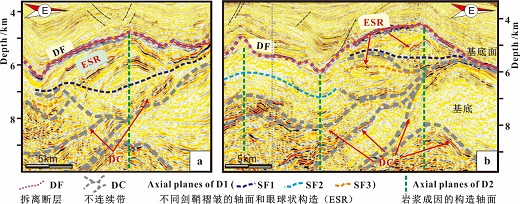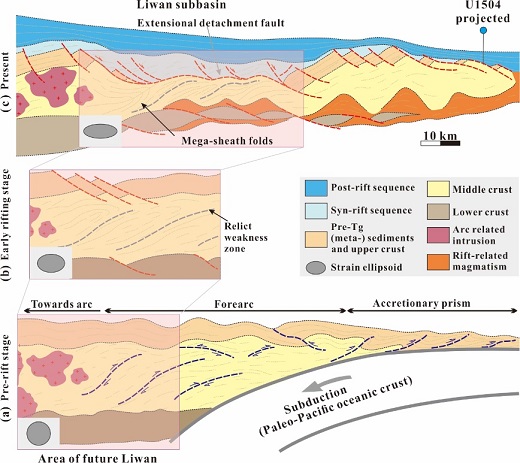

Sheath folds recognized on kilometer scale are rare and only described in salt tectonics in seismic data. Here, we present mega‐sheath folds spectacularly imaged in a 3‐D seismic survey in the seismic basement flooring the hyperextended Liwan subbasin in the northern margin of the South China Sea. The sheath folds show eye structures delimited by anastomosing discontinuities. The axial planes of the sheath folds are subparallel to a rift‐related, extensional detachment surface separating hyperextended seismic basement from the syn‐rift sedimentary sequence. The sheath folds as well as the anastomosing discontinuities formed during hyperextension by ductile shearing of the forearc inherited and prestructured metasediments. The ductile shearing eventually resulted in the metasediments derived from midcrust unroofed at the footwall of an extension detachment fault. The discovery of mega‐sheath folds and ductile deformation within the basement conflicts with the general assumption that hyperextended domains are in the brittle field. The new seismic observations show the importance of forearc inherited, prestructured anisotropic basement controlling the crustal rheology during hyperextension.

A wealth of research has established the classic crustal model with a strong brittle upper crust and a weak ductile lower crust. The styles of deformation depend on rheological and mechanical properties of the materials and generally exhibit brittle faulting in the upper crust and ductile flow in the lower crust, respectively. However, remarkable changes in the crustal rheology and mechanics can occur in strongly inherited, complex geological settings, which up to date have not been well established. In this study, we present and discuss the occurrence of mappable sheath folds generated under high ductile shear strain in metasediments in the basement, and we decipher the questions of when, how, and in what conditions these structures formed. Our results demonstrate that these mega‐sheath folds formed within a forearc inherited anisotropic basement, and the rocks are derived from midcrustal levels. During hyperextension, they were unroofed in the footwall of a major extensional detachment. Ductile deformation and shearing became responsible for the extreme thinning of the crust.